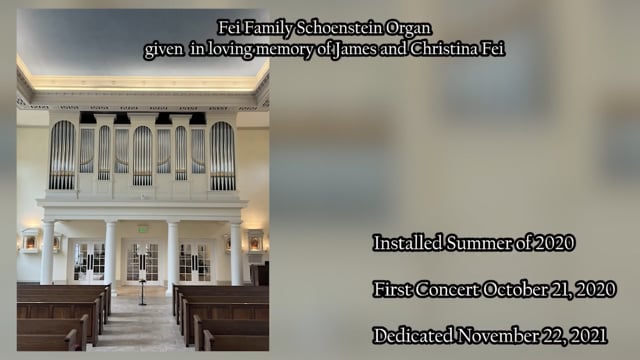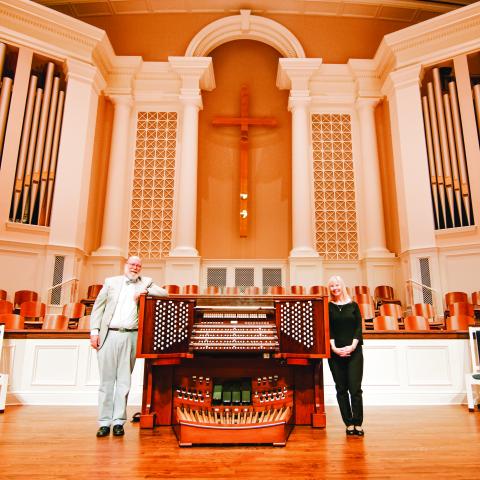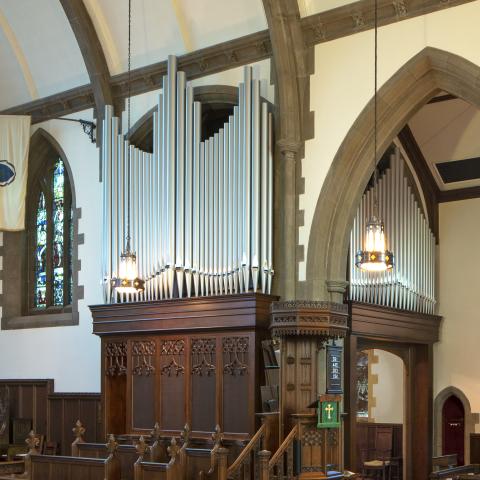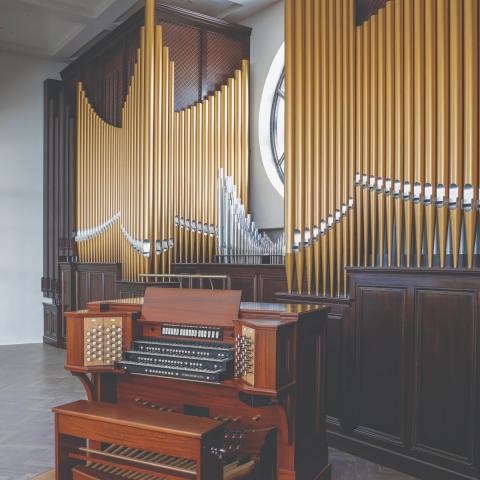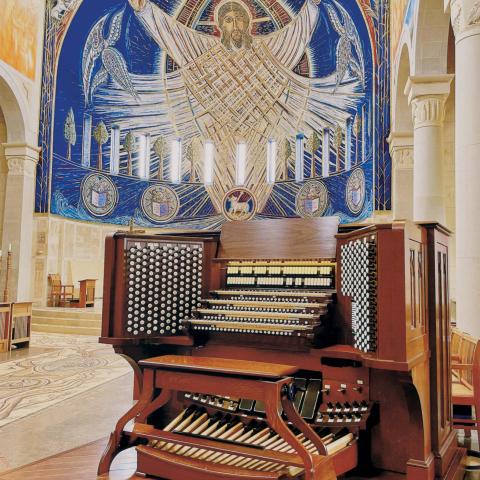Schoenstein & Co. Pipe Organ Builders, Benicia, California; Bishop Gadsden Episcopal Retirement Community, Charleston, South Carolina

The masked organ man
After installing more than seventy new pipe organs and dozens of rebuilds and renovations in almost every condition and environment I could think of, a new challenge was thrown into the mix, Covid! Installing a pipe organ at its best is a logistics challenge. Finding a time when we can take over a church six days a week for a month or more, being sure the organ (in a huge 18-wheeler), our crew, and hoisting equipment all arrive at the same hour, arranging for transportation and good lodging of our men who work a 63-1⁄2-hour week can be a coordination nightmare.
We were supposed to begin the installation of Opus 179 in the chapel of Bishop Gadsden Episcopal Retirement Community in May 2020, but with Covid’s emergence and the fact we were working with an obviously vulnerable population, we were forced to postpone the installation to give the client and us time to prepare for the new Covid challenges. Finally all agreed we could begin in August 2020, and we set out to take every precaution we could to protect ourselves and the Bishop Gadsden community. We had facemasks, hand sanitizer, and implemented our own temperature monitoring system each morning before even departing the hotel.
Bishop Gadsden also instituted many layers of safety, beginning with mandatory masking and daily temperature checks at the parking lot gate. We would have to return to the hotel if we failed to pass. We were given color-coded stickers for our name badges to let others know we had been cleared to work. Management installed an electronic automated temperature station inside the chapel that we could use to monitor ourselves during the day. We were even not allowed to use the existing restrooms and instead had a porta-potty and a garden hose with dish soap. The portable restroom outside in the summer was one of the most unpleasant parts of the job for obvious reasons, but in addition to the hot and humid conditions, each time we would go out, we would come back in with dozens of mosquito bites! The hotel had its own set of policies in place, such as masking in common areas, the gym was closed, and even the complimentary breakfast was changed to just a simple paper bag with an apple, a muffin, and a carton of milk. Hard to imagine but I sure did miss the mystery meat and reconstituted eggs that we regularly get.
Just traveling from California to Charleston was challenging with Covid screening and facemask mandates in the airport and on the plane. In some ways, however, travel was a bit easier as there was almost no one traveling! There is a silver lining in everything if you look for it.
Even with the logistical challenges and the inconveniences that Covid thrust upon us, the installation was a total success. However, Covid still wasn’t done with Opus 179. The dedication of the organ was put off indefinitely! Nigel Potts kindly offered to give a preview concert on October 22, 2020, for those who could safely attend. The formal dedication and blessing of the Fei Family Organ took place on November 18, 2021. On the next day Jeffrey Smith, music director of St. Paul’s Parish K Street in Washington, D.C., played a recital covering a wide range of repertoire plus exuberant hymn singing by the happy audience.
—Chris Hansford
Schoenstein Installation Foreman
Design for versatility
When one thinks of a chapel at a retirement community, even a very nice one, what first comes to mind is a small, heavily carpeted room on the first floor with a piano and, possibly, a digital instrument played by a local keyboardist. The chapel at Bishop Gadsden in Charleston, South Carolina, could not be any more different. On the other end of the spectrum, their Southern-Colonial-style chapel is of generous size (approximately 50 by 70 feet and 25 feet tall), with tile floor, traditional padded pews, tall windows, an elevated pulpit, gold leaf engravings of The Lord’s Prayer, Credo, and Ten Commandments, and a painting of “The Presentation in the Temple” behind the altar. In the back of the room, an elevated gallery serves as the home for a free-standing instrument.
The challenge ahead of us lay in designing an instrument within limited space and height while also providing an array of color that will fulfill the needs of this community chapel and occasional visiting recitalists. The room, while sizable for the typical retirement home, has the quality of intimacy without feeling claustrophobic. The organ needs to fit the same bill: colorful intimacy without overpowering the space.
The result is Schoenstein & Co. Opus 179, a three-manual, fourteen-voice instrument. On paper, one may notice similarities to the color palette of Opus 153 at Christ & Saint Stephen’s in New York City (See Nigel Potts’s tonal demonstration on YouTube @ tinyurl.com/4eumtt3c). However, Opus 179 stands apart in how it is adapted to the room’s acoustic and tonal properties. The Bishop Gadsden Chapel accentuates the high-middle frequencies above 1⁄2′ (think page turns, clapping, and human speech), with an adequate distribution of bass tone; reverberation time around 1-1⁄2–2 seconds. Christ & Saint Stephen’s is a wide, low ceiling room with very little reverberation.
Were Opus 153 transplanted to the home of Opus 179, it would not be successful. After all, the room is as much the instrument as the pipes. Especially with the chapel at Bishop Gadsden, care was taken when pre-voicing this organ in the shop. A conservative approach allowed us to more easily bring the ranks up to their final mark instead of having to reign them in.
Another aspect of Opus 179 that we have found successful in previous instruments is the use of a third keyboard as, in essence, a coupling manual. Instead of relying on a plethora of couplers, however, they have dedicated drawknobs. Here one will find solo, accompaniment, and ensemble voices. Employing this technique makes the organ more versatile and enables the organist’s registrational creativity to shine. The third manual paired with double expression stops also gives the aural illusion of a third division! Sixteen ranks become that much more flexible.
Limited vertical height dictated a single-level instrument with a greater length than height. With the main chests lowered as much as possible into the mechanical level, the remaining space is not much more than six feet. The expressive Great division on the left houses the expected principal chorus of 8′, 4′, and 2′ Mixture III in addition to a softer 8′/4′ Corno Dolce/8′ Flute Celeste pairing, 8′ Harmonic Flute (Corno Dolce bass to tenor G), and Clarinet. Other than being hyper-conscious of Harmonic Flute windiness accentuation in the room, these ranks are consistent with previous instruments.
The Swell division, on the right side of the organ, has most of the instrument’s unification. The Bourdon serves as the Pedal Bourdon at 16′ (available in the Swell also) and continues as a Chimney Flute at 4′ C. The 8′/4′/2′ Salicional is the division’s unit echo diapason with a slight string edge as ample counterparts to both the Great chorus and Swell Gamba. The Oboe Horn serves as another color reed, a counterpart to the Great Clarinet, and also represents the softer 16′ reed available in the Pedal adding support without too much power. Inner shades regulate the 8′ Gamba, its Celeste (full compass), and the 16′/8′ Tuba Minor. Rounding out the instrument is an independent Pedal Violoncello and Contrabass unit sitting in front of the Great shades. Metal down to 16′ C, it provides independent foundational support for the entire instrument.
Typically, with instruments of a modest size of sixteen ranks, organists are often “stuck” with ordinary combinations of a principal here, a flute there, and maybe a couple of reeds. They may resort to hand acrobatics to achieve a different sound or color they want. Flutes may sound the same—the reeds too close in character. At Bishop Gadsden, each of the fourteen voices is unique. They evolve as they move from low C to high C. No two ranks sound the same. The Solo (third) manual opens the door for organists to more easily achieve the sound they are looking for, and double expression adds another dimension of creativity for the organist. The result is an organ that sounds as though it has ten more ranks than it actually has. Each one plays a vital and equal role in its success.
—David H. Anderson
Schoenstein Service Manager & Voicer
Success = People who get things done!
In 2006 Bishop Gadsden Episcopal Retirement Community celebrated completion of its beautiful chapel modeled in the traditions customary to eighteenth-century South Carolina Anglican churches. The architect was Dan Beaman of the firm Cummings & McCrady. An organist with a custom digital instrument in his home, he would not leave the project without provision for a future pipe organ. The stout foundations for an organ gallery were key points on the first day of construction.
In fall of 2017, the dynamic and much beloved President/CEO of Bishop Gadsden, Bill Trawick, set about completing the chapel with the long-awaited pipe organ. He asked Nigel Potts, then canon organist and director of music at Grace Church Cathedral in Charleston, to work along with Dan Beaman as consultants on musical and architectural matters. Bishop Gadsden resident Patty Fei stepped forward to make the dream a reality by funding what was to become known as the Fei Family Organ in memory of her husband James and their daughter Christina.
While the organ was being built in California, Bill Trawick retired, and vice president, Sarah E. H. Tipton, became president/CEO. She and a fine staff supervised all the preparation for the organ’s installation. The architect in charge of designing the organ gallery and the organ casework was Ben Whitener of Cummings & McCrady. Our design director Glen Brasel worked closely with Ben and with Brett Gerbracht of JMO Woodworks, Charleston, in merging the organ’s inner works with the case. For steadfast support during the installation and continuing, we are ever grateful for the excellent help of Mike Anderson, facilities, and Catie Murphy, administration.
The continuing program of the chapel is under the direction of the Rev. Charles Jenkins. The chapel organist is Clara Godsell.
—Jack M. Bethards
Schoenstein & Co.
Builder’s website: schoenstein.com
Retirement community website: www.bishopgadsden.org
Photo credits: Louis Patterson and Bishop Gadsden Archive
GREAT (II - Expressive)
8′ Open Diapason 61 pipes
8′ Harmonic Flute 42 pipes (Corno Dolce bass)
8′ Corno Dolce 61 pipes
8′ Flute Celeste (TC) 49 pipes
8′ Vox Celeste II (Swell)
4′ Principal 61 pipes
4′ Corno Dolce (ext) 12 pipes
2′ Mixture III† 166 pipes
8′ Tuba Minor (Swell)
8′ Clarinet 61 pipes
Tremulant
Great Unison Off
Great 4′
†Mixture does not octave couple
SWELL (III - Expressive)
16′ Bourdon (wood, ext) 12 pipes
8′ Salicional 61 pipes
8′ Chimney Flute 61 pipes
8′ Gamba† 61 pipes
8′ Vox Celeste† 61 pipes
8′ Flute Celeste II (Great)
4′ Salicet (ext) 12 pipes
4′ Chimney Flute (ext) 12 pipes
4′ Flute Celeste II (Great)
2-2⁄3′ Nazard (from Chimney Flute)
2′ Fifteenth (ext) 12 pipes
16′ Bass Tuba† (ext) 12 pipes
16′ Contra Oboe (ext) 12 pipes
8′ Tuba Minor† 61 pipes
8′ Oboe Horn 61 pipes
Tremulant
Swell 16′
Swell Unison Off
Swell 4′
†In separate box inside Swell
SOLO (I)
SOLO STOPS
8′ Open Diapason (Great)
8′ Harmonic Flute (Great)
8′ Oboe Horn (Swell)
8′ Clarinet (Great)
16′ Bass Tuba (Swell)
8′ Tuba Minor (Swell)
ACCOMPANIMENT STOPS
8′ Corno Dolce (Great)
8′ Flute Celeste (Great)
8′ Gamba (Swell)
8′ Vox Celeste (Swell)
ENSEMBLE STOPS
8′ Salicional (Swell)
8′ Chimney Flute (Swell)
4′ Salicet (Swell)
4′ Chimney Flute (Swell)
2-2⁄3′ Nazard (Swell)
2′ Fifteenth (Swell)
Solo 16′
Solo Unison Off
Solo 4′
PEDAL
32′ Resultant
16′ Contrabass 32 pipes
16′ Bourdon (Swell)
8′ Open Diapason (Great)
8′ Violoncello (ext) 12 pipes
8′ Salicional (Swell)
8′ Chimney Flute (Swell)
4′ Octave (Great Open Diapason)
4′ Flute (Great Harmonic Flute)
16′ Bass Tuba (Swell)
16′ Contra Oboe (Swell)
8′ Tuba Minor (Swell)
4′ Clarinet (Great)
COUPLERS
Great to Pedal
Great to Pedal 4′
Swell to Pedal
Swell to Pedal 4′
Solo to Pedal
Solo to Pedal 4′
Swell to Great 16′
Swell to Great
Swell to Great 4′
Solo to Great
Great to Solo
Swell to Solo
MECHANICALS
Solid State Capture Combination Action:
5,000 memories
48 pistons and toe studs
3 reversibles
Programmable piston range
Piston sequencer
Record/Playback system
14 voices, 16 ranks, 995 pipes
Electric-pneumatic action

